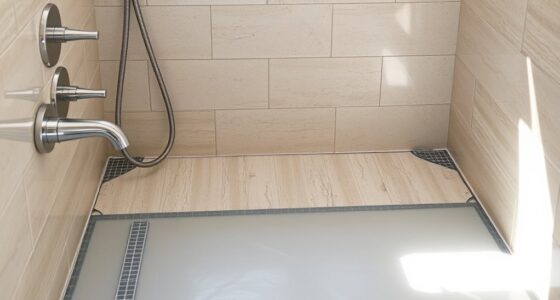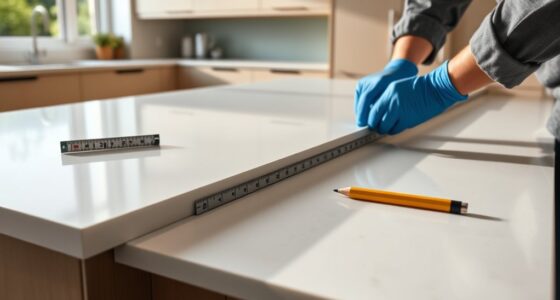To soundproof your bedroom for better sleep, start by identifying external and internal noise sources and then focus on sealing gaps around windows, doors, and vents with high-quality sealant. Upgrade your walls and ceiling with soundproof materials like acoustic panels, double-glazed windows, and mass-loaded vinyl for extra insulation. Arrange furniture to block noise and consider using white noise machines or calming sound masking techniques. If you continue exploring, you’ll discover more effective ways to create a peaceful sleep space.
Key Takeaways
- Identify and monitor external and internal noise sources to target specific soundproofing solutions effectively.
- Enhance walls, windows, and ceilings with soundproof materials like acoustic panels, double-glazed windows, and mass-loaded vinyl.
- Seal gaps around doors, windows, and vents to prevent sound leaks and improve insulation.
- Optimize furniture placement by positioning the bed away from noise sources and using heavy curtains or barriers.
- Use white noise machines or natural sound masking to create a calming sleep environment and reduce disturbance.
Assessing and Identifying Noise Sources

Before you can effectively soundproof your bedroom, you need to identify where the noise is coming from. Start with noise monitoring—pay attention to the times when noise levels peak and note the types of sounds you hear. This helps you differentiate between sources, whether it’s traffic, neighbors, or household appliances. Listen carefully to pinpoint whether noise is coming from outside or inside your room. Use simple tools like a portable decibel meter or even a smartphone app to measure sound levels. By distinguishing between different sources, you’ll know which areas need the most attention. Accurate source differentiation ensures your soundproofing efforts target the real problem, making your bedroom a quieter, more restful space. Incorporating knowledge about soundproofing materials can further enhance your ability to select appropriate solutions for specific noise sources.
Enhancing Walls and Ceilings for Sound Absorption

Once you’ve identified the main sources of noise, focusing on your walls and ceilings can considerably reduce sound transmission. Start by adding soundproof curtains to your windows, which block outside noise and dampen sound reflections. Upgrading to window double glazing also substantially improves sound insulation, preventing noise from penetrating your room. For your walls and ceilings, consider installing acoustic panels or foam tiles that absorb sound waves, reducing echo and transmission. You can also add mass-loaded vinyl or extra drywall layers to increase wall density. Ceiling-mounted soundproofing options, like suspended acoustic tiles, help minimize noise from above. Understanding supermarket hours can help in planning shopping trips to avoid busy times and reduce noise-related stress, especially if your household has different schedules. Combining these strategies creates a layered barrier, making your bedroom quieter and more conducive to restful sleep.
Sealing Gaps and Cracks to Prevent Noise Leakage
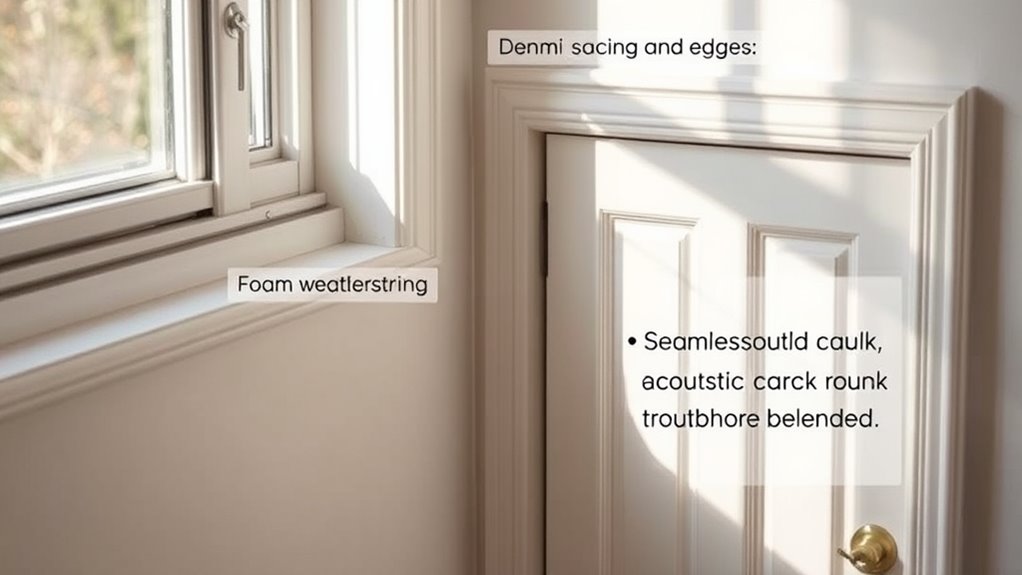
Start by identifying where noise can enter your bedroom, such as around windows, doors, and electrical outlets. Use a high-quality sealant to close these gaps thoroughly, preventing sound from leaking in or out. Proper sealing makes a noticeable difference in creating a quieter, more restful space. Additionally, addressing environmental impacts like air pollution from outdoor noise sources can further enhance your bedroom’s tranquility.
Identify Noise Entry Points
Identifying noise entry points is a crucial step in soundproofing your bedroom, as even small gaps can let in unwanted sound. Start by inspecting door hinges, as gaps here can cause noise to leak through. Check the edges of your window frames as well; gaps around windows often let in external noise. Look for cracks around the perimeter of doors and windows, and listen carefully when nearby sounds occur—these can reveal overlooked entry points. Don’t forget to examine any gaps near electrical outlets, vents, or wall fixtures. Pinpointing these areas allows you to address them directly, reducing noise infiltration. Additionally, understanding sound transmission paths can help you identify less obvious entry points that might require extra sealing. By thoroughly identifying all potential noise entry points, you’ll lay a solid foundation for effective soundproofing and enjoy quieter, more restful nights.
Use Sealant Effectively
After pinpointing all potential noise entry points, the next step is to seal those gaps and cracks effectively. You should focus on proper sealant application to ensure a tight barrier against sound leaks. Use a high-quality sealant designed for gap filling, which sticks well and remains flexible over time. Apply the sealant smoothly into cracks around windows, door frames, electrical outlets, and baseboards. Make sure to press it firmly into the gaps to prevent any air or sound from slipping through. Smooth out excess sealant for a clean finish, and allow it to cure fully before testing your soundproofing. Properly sealing these areas will considerably reduce noise transfer, creating a quieter, more restful bedroom environment. Additionally, understanding AI in Education can help you explore innovative solutions for monitoring and improving acoustic treatments in your space.
Using Soundproofing Materials and Barriers
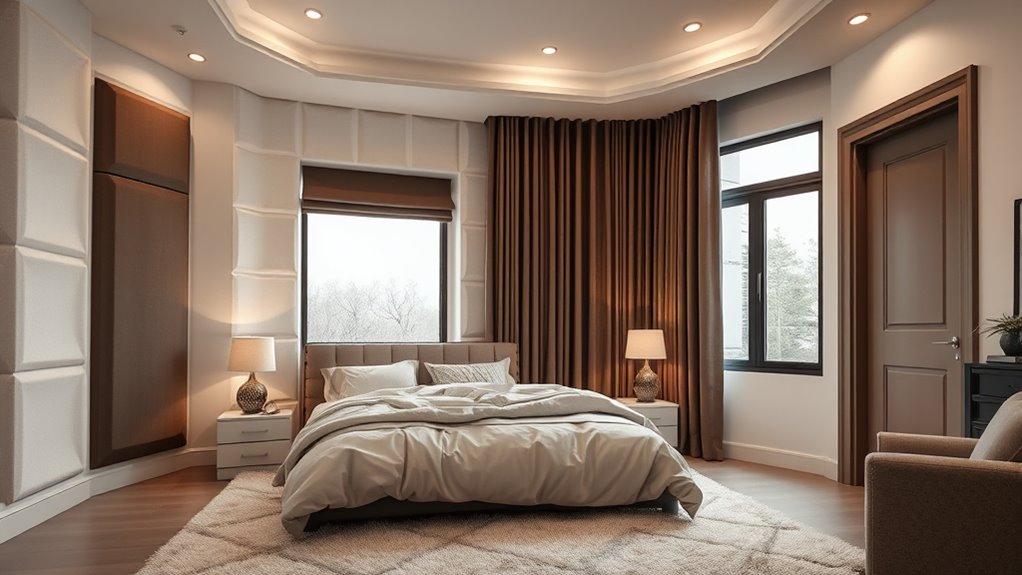
Installing acoustic panels can markedly reduce noise reflections and echoes in your bedroom. Make sure you seal gaps around panels and other barriers to prevent sound leaks. Combining these strategies creates a more effective soundproof environment for better sleep. Additionally, integrating soundproofing barriers like heavy curtains or door seals can further enhance noise reduction.
Acoustic Panels Installation
To effectively soundproof your bedroom, installing acoustic panels is one of the most practical steps you can take. These panels absorb sound waves, reducing echoes and external noise. When choosing panels, consider decorative aesthetics so they complement your room’s style—available in various colors and designs. Proper placement is key; install them on walls facing noisy sources for maximum impact. Also, keep ventilation considerations in mind; avoid blocking vents or airflow paths, which could lead to discomfort or humidity issues. Use mounting hardware that allows easy removal or adjustment if needed. Acoustic panels are a versatile, effective solution that enhances both the soundproofing and visual appeal of your bedroom, creating a calmer, more restful environment. Incorporating Kia Tuning options such as suspension upgrades or performance modifications can further improve your overall comfort and acoustic environment.
Sealing Gaps Effectively
Sealing gaps in your bedroom is a highly effective way to block out unwanted noise and improve your sleep environment. Start by inspecting door hinges and window frames for gaps where sound can seep through. Tighten loose hinges and add weatherstripping or door sweeps to create a seal. For windows, install acoustic caulking around frames or use sealant strips to close gaps. Consider using draft stoppers or acoustic curtains to further block noise. Proper sealing prevents sound from traveling through small openings, making your room quieter and more peaceful. Additionally, utilizing soundproofing materials can significantly enhance the effectiveness of your soundproofing efforts. Focus on these common problem areas, and you’ll notice a significant reduction in noise disturbances. Sealing gaps is a simple, cost-effective step toward a more restful sleep environment.
Optimizing Bedroom Layout and Furniture Placement

Arranging your bedroom thoughtfully can considerably reduce noise and create a more peaceful sleep environment. Start with window treatments like heavy curtains or soundproof blinds to block outside noise. Position your bed away from shared walls or windows that face noisy streets to minimize sound intrusion. Use furniture placement strategically—place tall bookshelves or wardrobes against walls shared with noisy areas to act as sound barriers. Keep noise-generating items, such as TVs or computers, away from your sleeping area. Rearranging furniture not only improves flow but also dampens sound transmission. Focus on creating a layout that isolates your sleeping zone from external and internal noise sources. Additionally, incorporating soundproofing materials into your bedroom can further enhance noise reduction. This simple step can significantly enhance your sleep quality by reducing disruptions and fostering a calm, quiet atmosphere.
Incorporating White Noise and Other Sound Masking Techniques
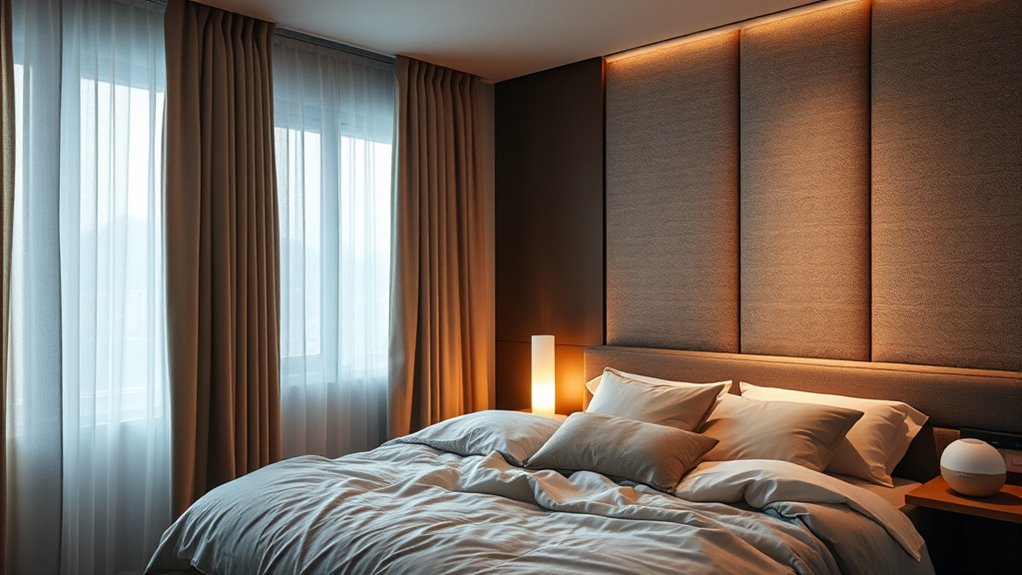
Incorporating white noise and other sound masking techniques can effectively drown out disruptive sounds and create a more tranquil sleep environment. You can achieve this with simple methods like:
- Playing nature sounds, such as rain or forest ambiance, to mask background noise and promote relaxation.
- Using a white noise machine or app to generate consistent, soothing soundscapes.
- Employing voice masking techniques by speaking softly or using recorded voices to cover intrusive noises.
- Combining these methods with adjustable volume settings to find the perfect balance for your sleep. These techniques help create a calming environment, making it easier to fall asleep and stay asleep. With consistent use, you’ll notice a significant improvement in sleep quality and overall restfulness. Additionally, understanding sound masking techniques can further enhance your sleep environment.
Frequently Asked Questions
What Are the Most Cost-Effective Soundproofing Methods for Bedrooms?
You want cost-effective ways to soundproof your bedroom, and affordable DIY solutions are perfect. Use budget-friendly materials like weatherstripping on doors and windows to block noise. Hang heavy curtains or add rugs to absorb sound. Seal gaps with foam or caulk, and consider DIY acoustic panels made from inexpensive materials. These methods are easy, inexpensive, and effective, helping you enjoy quieter, more restful sleep without breaking the bank.
How Long Does It Typically Take to Notice Improvements After Soundproofing?
Once you implement soundproofing measures, you typically start noticing noise reduction and sleep quality improvement within a few days to a week. The noise reduction timeline varies depending on the methods used, room size, and noise levels. You might feel more rested sooner as the environment becomes quieter. Consistently using effective soundproofing techniques helps optimize your sleep experience, making it easier to fall asleep and stay asleep longer.
Can Soundproofing Affect Room Ventilation or Air Quality?
Soundproofing can impact ventilation and air quality because adding dense materials or sealing gaps might restrict airflow. If you block vents or windows, your room’s ventilation impact increases, potentially reducing fresh air and affecting air quality. To avoid this, make certain you maintain proper ventilation by using alternative airflow solutions like vent fans or air purifiers. Properly balancing soundproofing with ventilation helps you enjoy both quiet and healthy, fresh air.
Are There Eco-Friendly Soundproofing Options Available?
Think of eco-friendly soundproofing options like a gentle breeze guiding you to better sleep. You can choose recycled materials, such as reclaimed wood or acoustic panels made from recycled fibers, which help reduce waste. Natural insulation like sheep’s wool or cork also provides soundproofing while being sustainable. These options effectively block noise without harming the environment, making your bedroom a peaceful sanctuary and supporting eco-conscious living.
How Do Soundproofing Solutions Impact Indoor Humidity Levels?
Soundproofing solutions can affect your indoor humidity levels, so maintaining humidity balance and moisture control is key. Some materials, like foam panels or heavy drapes, may trap moisture, leading to increased humidity and potential mold growth. To prevent this, you should use dehumidifiers or ensure proper ventilation. By managing humidity balance, you keep your space comfortable and reduce the risk of moisture-related issues while enjoying effective soundproofing.
Conclusion
By applying these soundproofing strategies, you can substantially improve your sleep quality. Did you know that noise pollution can increase stress levels and disrupt rest, with studies showing an average of 66% of people affected? Taking steps like sealing gaps, adding soundproof barriers, and using white noise can make a real difference. Don’t wait—creating a quieter bedroom environment is within your reach and can lead to more restful, restorative sleep every night.



